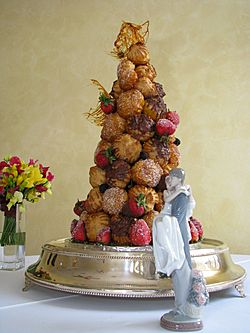Croquembouche facts for kids

Croquembouche wedding cake
|
|
| Alternative names | Croque-en-bouche, Pièce-en-Montée |
|---|---|
| Type | Choux pastry |
| Course | Dessert |
| Place of origin | France |
| Main ingredients | Profiteroles, chocolate, caramel |
A croquembouche (say "kroh-kahn-BOOSH") is a special French dessert. It's made from many small, round pastries called profiteroles. These are stacked high to look like a cone or pyramid. Thin threads of caramel hold them all together.
This impressive dessert is often served at big celebrations in France and Italy. You might see it at weddings, baptisms, or first communion parties. It's a sweet and crunchy treat that's fun to share!
Contents
What Does "Croquembouche" Mean?
The name croquembouche comes from a French phrase. It means "crunches in the mouth." This makes sense because the caramel holding the pastries together is crunchy!
What Does a Croquembouche Look Like?
A croquembouche is usually made of profiteroles filled with cream. These are carefully piled up to form a tall cone shape. Then, thin, shiny threads of spun sugar (caramel) are wrapped around them. This not only holds the tower together but also makes it look beautiful.
Sometimes, people add other decorations to a croquembouche. These can include:
- Sugared almonds
- Chocolate pieces
- Edible flowers
- Colorful macarons
- A smooth chocolate coating called ganache
The History of This Sweet Tower
The idea for the croquembouche dessert has been around for a long time. Many people think a famous French chef named Antonin Carême invented it. He wrote about it in his cookbook in 1815.
However, similar desserts were mentioned even earlier. They appeared in other French cookbooks from 1806 and 1815. In those days, these fancy desserts were called entremets. They were served between the main courses at large, important banquets.
A Giant Croquembouche Record
On March 6, 2009, something amazing happened in Pune, India. Students and teachers from a hotel management school built a giant croquembouche! It was recorded in the Limca Book of Records as India's biggest. This incredible dessert stood 4.5 meters (about 14.7 feet) tall! Imagine how many profiteroles that took!
See also
 In Spanish: Croquembouche para niños
In Spanish: Croquembouche para niños

